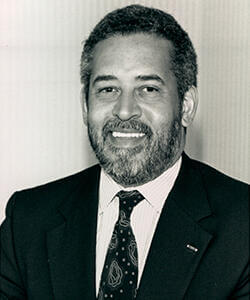Howard University Mourns the Passing of Harry Granville Robinson III

From the Office of University Communications:
It is with extraordinary reverence that we acknowledge the irreplaceable contributions of Harry Granville Robinson III (B. Arch. ’66, M.C.P. ’70), who passed away on Friday, June 13. Over the course of a career that spanned decades, he was instrumental in the transformation of the University into a modern, relevant, highly regarded institution of higher learning — serving as vice president for University administration, interim vice president for academic affairs, and dean of the School of Architecture and Planning [now the Department of Architecture in the College of Engineering and Architecture] for 16 years. We remain in his debt.
A Howard alumnus, Robinson’s transformative legacy at his alma mater will be evident for generations. Born at Freedman’s Hospital as the son of Howard graduates and the grandson of one of Howard’s earliest faculty members, his connection to the University spanned his entire life. Recruited onto the University’s faculty at the insistence of its students, he grew the curriculum and expanded pathways for minorities into architecture careers. He led the development and implementation of the University’s “UniverCity 20/20” master plan and inspired the series of monuments in The Valley honoring the founding of “Divine Nine” Greek-lettered fraternities and sororities at Howard. The book he coauthored with Hazel Ruth Edwards (B.A. ’86), Ph.D., “The Long Walk: The Placemaking Legacy of Howard University,” mirrored the core tenants of Robinson’s master plan for Howard: veneration for Howard’s interconnected topography and architecture as the campus seamlessly creates the spaces needed for the future with respect for the history already manifested. He was the ultimate exemplar of Howard citizenship, who shepherded the physical campus into the modern day, and was honored with the Distinguished Postgraduate Achievement Award, the highest alumni honor bestowed by the University.
Harry Robinson was also a giant national leader with broad influence. He was awarded the Soldier for Life Award on the 243rd birthday of the U.S. Army after heroic service during the Vietnam War, for which he received a Bronze Star and Purple Heart. He served on the board of directors of the Vietnam Veterans Memorial Fund, which oversaw the creation of the Vietnam Veterans Memorial. He also chaired the U.S. Commission on Fine Arts as the capstone to service on the commission that lasted nearly a decade and was the first Black president of both the National Architectural Accrediting Board and the National Council of Architectural Registration Boards. He was a three-term chairman of the District of Columbia Board of Architecture and Interior Design, a founding director of the Washington Arts Consortium, and a trustee of the National Building Museum and the Cooper–Hewitt, Smithsonian Design Museum. In addition, he was the executive consulting architect for the American Battle Monuments Commission — again breaking barriers as the first Black person to serve in the role. Internationally, he headed the UNESCO International Commission on the Goree Memorial and Museum and oversaw the design of the House of Slaves museum on Gorée Island in Senegal, which, with its infamous Door of No Return, has dramatically exposed the world to the horrors of slavery.
Robinson took great pride in his work as an architect of consequence, designing public and private spaces around the world. He holds honorary membership in the Colegio de Arquitectos de Mexico, Sociedad de Arquitectos Mexicanos, and the Trinidad and Tobago Institute of Architects. A fellow of the American Institute of Architects (AIA), he received the Centennial Medal of the AIA’s Washington Chapter, the organization's top achievement.
Around the world, Robinson greatly influenced spaces where memories will be made by countless people for years to come. Here on campus, he pushed us to respect Howard as a physical place where the metaphysical occurs. Please join the Howard community in sharing our condolences and prayers with his family, friends, colleagues, and all who knew and loved him.
